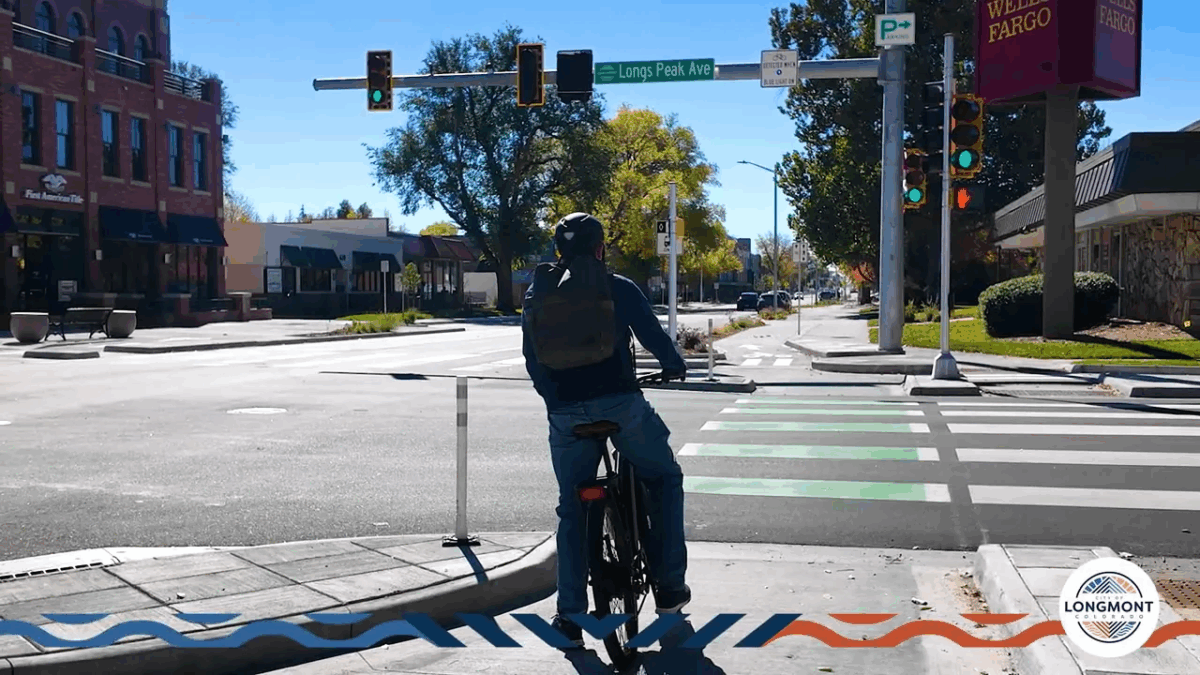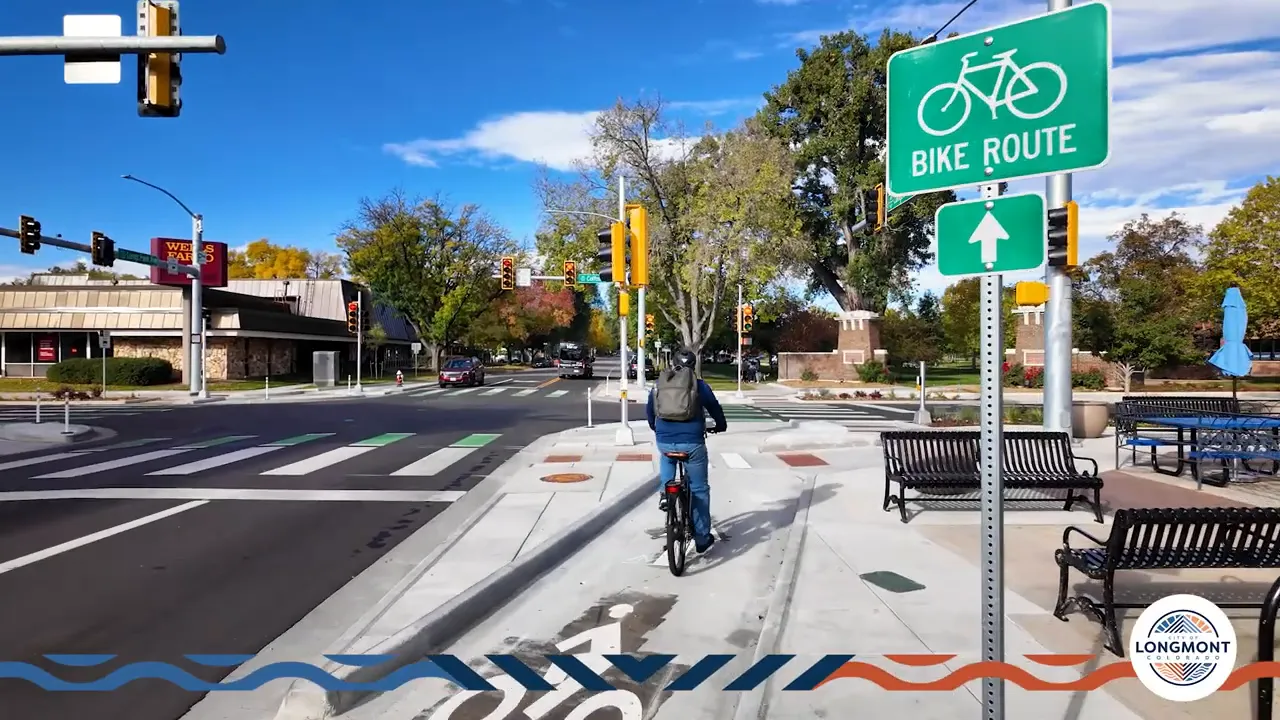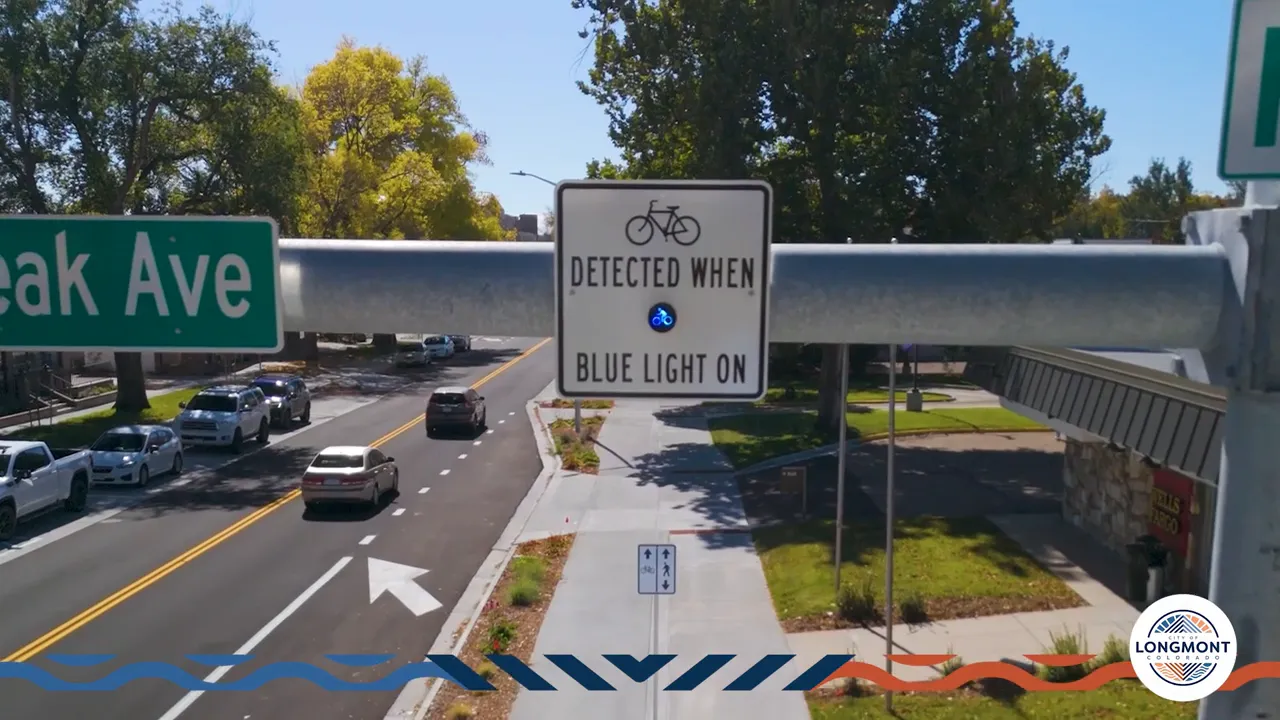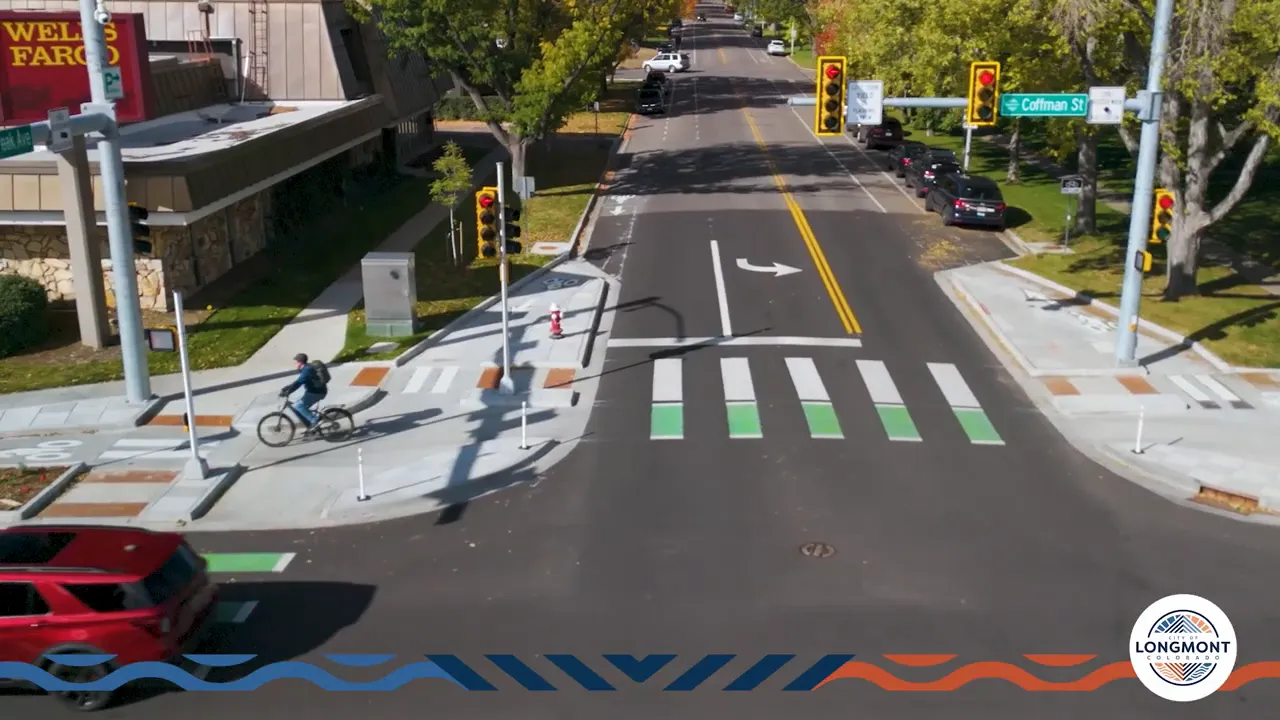When a Familiar Crossing Stops Feeling Familiar – Longmont is adopting “Protected Intersections”

It’s been hard to miss all the dust and construction if you’ve been driving around Longmont lately.
Here’s a breakdown of what they’re changing in the traffic patterns and the ideas behind them.
Longmont has introduced a new intersection design aimed at making streets safer and more comfortable for everyone who uses them. These are called protected intersections. They look familiar at first glance, but small changes in geometry and signal operation make a big difference for people driving, bicycling, walking, and using wheelchairs.
Where to find protected intersections in Longmont
Protected intersections are already installed in several locations across town.
Examples exist on Kaufman Street at 4th Avenue and on Longs Peak Avenue.
As more of these intersections are built, they will help knit together a safer and more comfortable street network for everyday trips by foot, bike, or car.
Expect new installations to follow similar design principles:
- corner islands
- dedicated bike lanes and detection
- clear crosswalk markings
These features are intended to create consistent behavior expectations for anyone who uses the road.
What is a protected intersection?
A protected intersection keeps the same basic layout of a normal crossroads but adds specific features to separate and clarify spaces for each mode of travel. The goal is to reduce conflicts between vehicles and people walking or bicycling, slow turning vehicles, and improve visibility so people can see one another sooner and react safely.
Protected intersections are designed around three simple ideas: physically separate bicyclists from turning cars, give pedestrians shorter and safer crossings, and create a clear, low stress way for bicyclists to make left turns without merging into fast moving traffic.
Key elements of the design
Several consistent elements make a protected intersection work. Each plays a role in slowing vehicles, improving sight lines, and creating safer turning and crossing movements.
Corner islands
Corner islands are small raised or painted islands placed at the corners of the intersection. They do more than mark the corner. They make the turning radius for right turning vehicles smaller so drivers must slow down and take a tighter turn. This lower speed creates fewer and less severe conflicts with people walking and bicycling.

Corner islands also move pedestrians and bicyclists slightly away from the line of vehicle traffic, which shortens the crosswalk distance and increases visibility between drivers and people on foot or on bikes. A clear line of sight gives drivers a better chance to spot someone waiting to cross and to stop in time.
Separated bike lanes
Protected intersections pair corner islands with segregated bike lanes along the curb. These bike lanes keep bicyclists to the right of vehicles and give them a dedicated place to wait ahead of turning cars. The bike lane leads to a holding area at the corner island so bicyclists do not have to merge into traffic to turn left.

Bicycle detection signs and signals
Many protected intersections include bicycle detection, which senses when a bicycle is present and calls a green signal for their movement. A small indicator light on a sign often lights up to let the bicyclist know they have been detected. When the detector registers a bicycle, the signal timing will change so bicyclists get a safe, dedicated green movement without having to press a pedestrian crosswalk button.

How drivers should use a protected intersection
For drivers, a protected intersection will feel mostly familiar, but a few small changes in behavior will keep everyone safer.
- Watch for people in the bike lane on your right. Bicyclists often stop ahead of the vehicle lane, inside the bike lane, so expect to see them waiting just before the crosswalk.
- Avoid the corner island curves when turning right. The islands are placed to force a tighter turn and slower speed. Do not cut across the island. Cutting reduces the safety benefits and puts people in the crosswalk at risk.
- Always yield to people in crosswalks. The crosswalk is the same legal crossing as anywhere else. If someone is crossing, stop and let them finish crossing before moving forward.
- Look for bicyclists staging to turn left. Bicyclists using the two stage left turn will ride to the far corner and wait. Do not assume they will merge into vehicle traffic; they may be waiting for their green in the bike lane.
These adjustments require only small changes to driving habits but provide big improvements for safety and comfort for all street users.

How pedestrians and people using wheelchairs should use a protected intersection
Protected intersections keep pedestrians and people using mobility devices in mind. Crosswalks are placed to shorten the distance across the roadway and to keep waiting pedestrians visible to drivers.
- Use the white stripe crosswalks. The white-striped pedestrian crosswalk is the place to walk across. Do not use the green stripe crossing created for bikes.
- Take advantage of the corner island refuge. If traffic is heavy and the signal only gives partial gaps, the corner island can serve as a shorter, safer crossing zone to pause before finishing the crossing.
- Expect faster vehicle turning visibility. Because turning vehicles must take a tighter radius and slow down, it is easier to make eye contact with drivers and confirm they are stopping.
These features shorten time spent in the roadway and reduce exposure to turning vehicles.
How bicyclists make left turns safely
Left turns are one of the most challenging maneuvers for bicyclists, especially when traffic is heavy or fast. Protected intersections offer a simple and safe two-stage turning method that eliminates the need to merge left across lanes of motor vehicle traffic.
The method works like this:
- Approach in the bike lane. Stay in the bike lane to the right as you come up to the intersection.
- Move forward to the corner island. Ride to the holding area at the corner island and stop there. This is the counterclockwise position that lines you up to make a left turn in two stages.
- Look for the bicycle detector light. A blue light on the bicycle detection sign will indicate when the system has registered your presence. This triggers a bicycle green signal without needing to press a crosswalk button.
- Cross to the next corner island when the light is green and safe. Ride straight across the intersection on the bike-crossing when your movement is permitted, to the opposite corner island. At this point you will be facing the direction you want to go.
- Turn your bike left and wait for the green. Once you are on the far corner island, complete the left turn by shifting to the bike lane and proceeding straight when the green signal allows.
This two-stage left turn keeps bicyclists out of high speed merging traffic and gives them a predictable, visible space to wait for their signal. It is especially helpful for people who do not feel safe asserting a left turn by merging across several lanes of cars.

Why protected intersections improve safety
Protected intersections combine geometry, signal timing, and visual separation to reduce the most common and dangerous conflicts on urban streets.
- Lower turning speeds. Corner islands force a smaller turning radius and slower right turns. Slower turning speeds reduce the severity of collisions and increase the time drivers have to see someone in the crosswalk or bike lane.
- Better visibility. Offset crossing and waiting areas make pedestrians and bicyclists easier to see from the driver position. Drivers have a clearer line of sight to the people they may interact with.
- Shorter crossing distances. Moving the crosswalk closer to the corner island shortens how far pedestrians have to cross, which reduces exposure to traffic and the time spent in the roadway.
- Predictable bicycle movements. The two-stage left turn and dedicated bike signal create a safer and more predictable way for bicyclists to make complex turns.
- Improved accessibility. The design explicitly shortens crossings and provides refuge areas for people using wheelchairs or other mobility devices.
Together, these benefits produce a street environment where all modes can co-exist with reduced risk and a clearer understanding of who yields and when.
Practical tips and common questions
Do bicyclists have to press a button?
No. When bicycle detection is installed, a small blue indicator light will let the bicyclist know they have been recognized. The detection triggers the appropriate signal phase, so there is no need to press the pedestrian button to get a green for bicycling movements.
Can drivers still make right turns?
Yes. The corner islands allow right turns but make drivers slow down. Drivers should avoid sweeping wide turns that cut across the island. Stay in the travel lane and follow the curve that the island sets, yielding to pedestrians and bicyclists as required.
What about bicyclists who are comfortable merging?
If a bicyclist prefers to merge and make a traditional left turn like a car, they can do so where the roadway and traffic conditions allow. The protected intersection simply provides an alternative that is safer and more comfortable for many people.
How should pedestrians identify the correct crossing?
Look for the white stripe crosswalk. The green striping in many protected intersections marks the space intended for bicyclists and can be confusing. Pedestrians and people using wheelchairs should use white crosswalk markings to make sure they are in the correct crossing path.
Quick checklist for each user
- Drivers — Watch the bike lane on your right. Avoid cutting the corner island. Yield in crosswalks.
- Bicyclists — Use the bike lane to the corner island. Look for the blue detection light. Use the two-stage left if you prefer.
- Pedestrians and mobility device users — Cross in the white stripe crosswalk. Use the corner island refuge if you need a break.
Final thoughts
Protected intersections are a thoughtful, evidence based tool for improving safety, comfort, and predictability on city streets. Small changes in curb placement, lane alignment, and signal operation add up to a much safer experience for people walking, bicycling, and driving. As these intersections become more common, they will help create a calmer, easier to navigate street network that better serves everyone.
Look for more protected intersections coming to Longmont and consider using the simple steps above to move through them safely and confidently.


